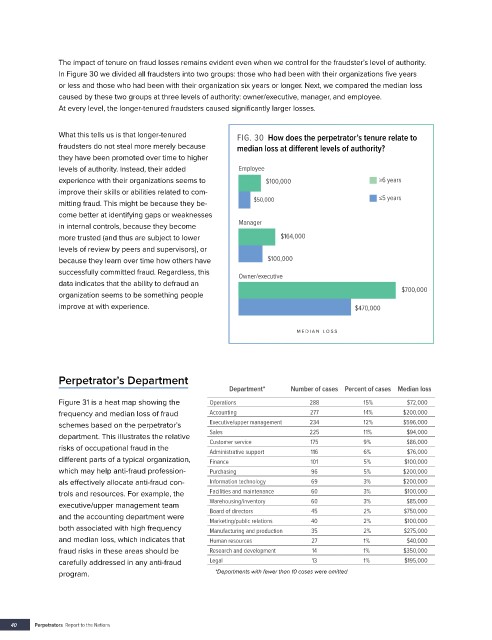Page 696 - ACFE Fraud Reports 2009_2020
P. 696
The impact of tenure on fraud losses remains evident even when we control for the fraudster’s level of authority.
In Figure 30 we divided all fraudsters into two groups: those who had been with their organizations five years
or less and those who had been with their organization six years or longer. Next, we compared the median loss
caused by these two groups at three levels of authority: owner/executive, manager, and employee.
At every level, the longer-tenured fraudsters caused significantly larger losses.
What this tells us is that longer-tenured FIG. 30 How does the perpetrator’s tenure relate to
fraudsters do not steal more merely because median loss at different levels of authority?
they have been promoted over time to higher
levels of authority. Instead, their added Employee
experience with their organizations seems to $100,000 ≥6 years
improve their skills or abilities related to com- ≤5 years
mitting fraud. This might be because they be- $50,000
come better at identifying gaps or weaknesses
in internal controls, because they become Manager
more trusted (and thus are subject to lower $164,000
levels of review by peers and supervisors), or
because they learn over time how others have $100,000
successfully committed fraud. Regardless, this Owner/executive
data indicates that the ability to defraud an $700,000
organization seems to be something people
improve at with experience. $470,000
MEDIAN L OSS
Perpetrator’s Department
Department* Number of cases Percent of cases Median loss
Figure 31 is a heat map showing the Operations 288 15% $72,000
frequency and median loss of fraud Accounting 277 14% $200,000
schemes based on the perpetrator’s Executive/upper management 234 12% $596,000
$94,000
department. This illustrates the relative Sales 225 11% $86,000
9%
175
Customer service
risks of occupational fraud in the Administrative support 116 6% $76,000
different parts of a typical organization, Finance 101 5% $100,000
which may help anti-fraud profession- Purchasing 96 5% $200,000
als effectively allocate anti-fraud con- Information technology 69 3% $200,000
trols and resources. For example, the Facilities and maintenance 60 3% $100,000
$85,000
executive/upper management team Warehousing/inventory 60 3% $750,000
Board of directors
45
2%
and the accounting department were Marketing/public relations 40 2% $100,000
both associated with high frequency Manufacturing and production 35 2% $275,000
and median loss, which indicates that Human resources 27 1% $40,000
fraud risks in these areas should be Research and development 14 1% $350,000
carefully addressed in any anti-fraud Legal 13 1% $195,000
program. *Departments with fewer than 10 cases were omitted
40 Perpetrators Report to the Nations

